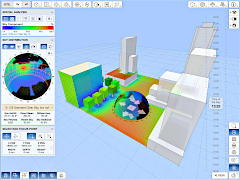SOLAR ANALYSIS
Site Analysis Metrics
Site analysis is an important tool for building designers to help guide the form and orientation of their designs to take optimum advantage of whatever amenity and resources are availabe. As the design develops, site analysis becomes even more important as a means of demonstrating compliance with building codes and meeting the energy efficiency and sustainability criteria set by clients and/or regulatory bodies. As with most building performance analysis though, there is no single metric that will solve all your design problems. Instead, you typically have to compare multiple metrics on each design iteration and try to make the best set of compromises for both your building and the impacts it will have on those that surround it. The aim of this article is to outline the range of site analysis metrics that can be computed and to loosely group them based on their input requirements.
Site Designer

This web app extends my dynamic daylighting tool to bring shading, solar radiation and view analysis to the level of an entire site rather than just a single room. It uses the same framework and infrastructure as the daylight tool, but with some more interesting snapping, editing and model generation functions. This means that it uses the same block-optimised ray-tracing routines, so the geometry is still limited to axially-aligned rectilinear blocks. However, I have added an experimental constructive solid geometry (CSG) model to automatically merge intersecting blocks into more complex shapes so that the intersecting edges are not shown. Another distinguishing feature is the ability to add multiple analysis grids, both flat and volumetric, and to automatically fit them to selected surfaces or volumes.
Solar Position
The position of the Sun in the sky varies continually throughout the day and also changes signficantly over the course of a year. It is also very location-dependant, so it is critical that you know the latitude and longitude of your development site before you begin any calculations. Despite our fundamental physical understanding of solar position as a result of experiencing it every day, calculating it at any specific date and time is by no means a trivial exercise. The tilted rotation of the Earth and its elliptical orbit around the Sun add significant complexity to the equations required. Add the fact that one day isn't actually the time required for a full rotation of the Earth around its axis and that 365 days isn't actually the time required for a full orbit around the Sun, and we're in for some real fun and games.
Sky Distribution
This article discusses the processes involved in determining the luminous distribution of daylight and solar radiation over the skydome in order to accurately account for the effects of shading and reflections in and around a building site. It looks at the mathematical models used and their implementation, as well as some of the issues associated with aggregating multiple skies over longer periods.
Significant Latitudes
This article discusses a range of latitude lines on the Earth's surface that have some solar significance. Latitude refers to one of the angular components that define a geographic location, more specifically to imaginary lines that run around the Earth parallel to the line of the Equator and vary from -90° at the South Pole to 90° at the North Pole, passing through 0° at the Equator. As the Earth's axis is tilted relative to the Sun, the amount of available solar radiation varies throughout the year giving us the four seasons. This seasonal variation is marked by solar-related minima and maxima that occur at particular latitudes.
Significant Days of the Year
This article discusses those days within the year that have some solar significance. Known as Solstices and Equinoxes, these days are defined by the cyclical nature of available solar radiation and mark the changing of the seasons. Understanding seasonal variations in temperature, daylight and solar radiation throughout the year is an important part of the building design process.
Significant Times of Day
Over the course of any 24 hour day, the world transitions from the darkness of night to the brightness of day, and then back again. As the Sun arcs its way through the sky during that process, it crosses a number of thresholds and reaches certain maxima that have long influenced man's activities, even today. This article discusses those particular times of day that have some solar significance, which include different stages of twilight, sunrise and sunset, as well as local and solar noon.
Solar Availability in Cities
Analysing solar and daylight availability in dense urban environment is quite a complex process and depends on dynamic overshadowing inter-relationships between buildings and other site obstructions. Accurately quantifying the effects of shading and overshadowing is key to the prediction of building performance metrics such as solar gains, daylight access and thermal behaviour, as well as the potential benefits of photovoltaics and other renewable energy sources. Not to mention increasingly stringent legislation on solar-access and rights-to-light. All this means that the use simulation tools to predict these complex effects are becoming increasingly necessary, as is the ability to visualise and convey this information obviously and effectively. The first part of this article deals with the means of mapping solar radiation and other metrics on buildings surfaces, whilst the second deals with calculating the full spatial variation in solar availability over the entire un-built volume of a site using an analysis grid.
Averaging Solar Radiation
For the most part, the mathematics of solar radiation is pretty straightforward. However, there are a couple of situations that are less intuitive than they first appear. This is definitely true in the calculation of average hourly incident solar radiation (insolation).